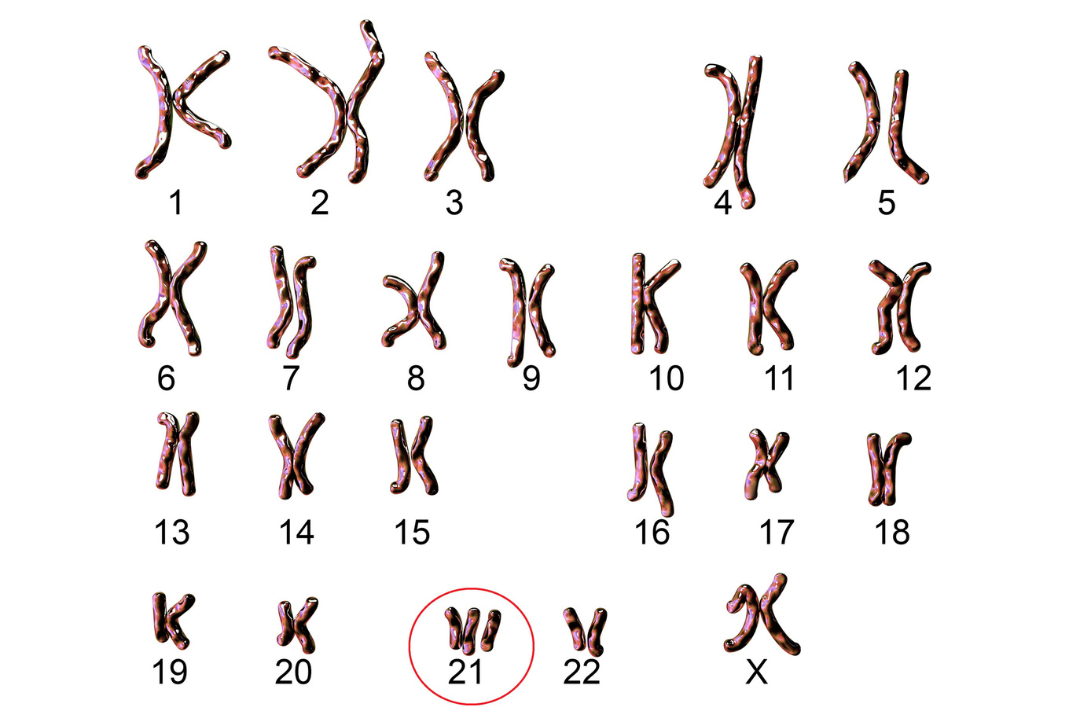Chromosomal Differences:
What is Aneuploidy?
Aneuploidy is a genetic condition that occurs when entire or partial chromosomes are lost or gained at the point of conception and development of the embryo into a fetus. Studies show this group of disorders affects 1 out of 150 pregnancies (1). It is important to first define and comprehend the functions of DNA and chromosomes before it is possible to understand aneuploidy.
An example of a karyotype of a human with three copies of chromosome 23 rather than the typical two copies. This is an example of the chromosomes of a person assigned female at birth with a diagnosis of Down Syndrome (discussed in more detail on this page).
DNA and Chromosomes
This image is of a set of human chromosomes for a typical 46 chromosome assigned male at birth. The 23rd pair of chromosomes in males are actually an X and Y chromosome, with the Y being slightly smaller than the X.
Our bodies are composed of trillions of cells, each serving as the microscopic building blocks of all living things. Within these cells, there exists deoxyribose nucleic acid (DNA), serving as the required genetic blueprint for development, growth, and reproduction. Given the amount of genetic material in humans, DNA is organized and packaged into structures known as chromosomes. Chromosomes function as storage containers for DNA, ensuring the efficient organization and transmission of genetic information. In humans, typical cells contain twenty-three pairs of chromosomes, one chromosome of each pair inherited from each parent, totaling forty-six. The interplay between DNA and chromosomes is crucial for the proper functioning of cells and, consequently, the overall well-being of an organism (1).
Causes of Aneuploidy
Aneuploid cells are classified as cells with a chromosome count either greater or fewer than forty-six. Aneuploidy arises due to random errors occurring during cell division during the early stages of conception where chromosomes fail to divide appropriately when forming the embryo and fetus. One of the fundamental mechanisms leading to aneuploidy is nondisjunction, which is when chromosomes do not separate properly during cell division resulting in an uneven distribution of genetic material. This failure in proper chromosome segregation can contribute to abnormal numbers of chromosomes in offspring, consequently giving rise to various genetic disorders (1).
External factors can induce chromosome loss and nondisjunction by interacting with different cellular components (6). Several factors contribute to an increased likelihood of nondisjunction events with a critical factor being the age of the pregnant parent. Research indicates that the likelihood of nondisjunction events rises with advancing age, emphasizing the importance of considering age-related factors in understanding chromosomal variation (4). Environmental influences play a role and increased risk for having a pregnancy with aneuploidy have been tied to smoking, alcohol consumption, and exposure to hazardous materials.
Types of Aneuploidy
Any deviation from the typical number of chromosomes can impact the outcome of a pregnancy. While aneuploidies can occasionally result in a live birth, the majority of these chromosomal abnormalities are incompatible with life, leading to spontaneous miscarriage within the first few weeks of pregnancy. Such cases are deemed inviable due to the severe disruptions in the normal chromosomal balance. Among the viable forms of aneuploidy, trisomies are the most frequently occurring. Trisomy involves the presence of an extra chromosome copy, resulting in three chromosomes instead of the usual pair. Notable examples include Trisomy 13, or Patau syndrome, Trisomy 18, or Edwards syndrome, and the most frequent, Trisomy 21, or Down syndrome. On the opposite end of the spectrum, monosomy indicates the absence of a chromosome. In humans, the only known viable monosomy is Turner syndrome. Individuals assigned female at birth are born with a single complete copy of the X chromosome and no Y chromosome (1,5). Understanding these chromosomal variations is crucial in assessing potential outcomes and providing appropriate medical care and support.
Is there a Screening or test for aneuploidy?
Thanks to advances in reproductive medicine, many methods exist to screen and diagnose aneuploidy. Screening is intended to inform about the chances a pregnancy is affected, whereas, diagnostic testing confirms or rules out any suspected presence of a disease-causing variant.
Learn more about pregnancy-related screenings and testing here.
Does testing have to occur before or during pregnancy?
The simple answer is no. All genetic screening and diagnostic testing is entirely optional. The decision to pursue testing is deeply personal, influenced by an individual's distinctive family-building goals, worldview, and medical history. While not mandatory, these examinations offer valuable information that can guide individuals in making informed choices. This includes decisions aimed at reducing the likelihood of having a child with a severe genetic disorder, preparing prospective parents for potential challenges associated with complex medical needs, and facilitating the garnering of additional support from medical specialists. Ultimately, the choice to undergo testing rests on the individual's autonomy and their unique considerations.
This page was researched and written by Lupe Martinez; edited and reviewed by Rachel Baer, MSc, and Andrew McCarty, MS, LCGC; Images developed with licensure from Canva.
Citations:
“Aneuploidy.” Cleveland Clinic. Reviewed August 25, 2022. https://my.clevelandclinic.org/health/diseases/24060-aneuploidy
Hardy PJ, Hardy K. Chromosomal instability in first-trimester miscarriage: a common cause of pregnancy loss? Transl Pediatr. 2018 Jul;7(3):211-218. doi: 10.21037/tp.2018.03.02. PMID: 30159247; PMCID: PMC6087828. https://www.ncbi.nlm.nih.gov/pmc/articles/PMC6087828/
Antonarakis SE, Skotko BG, Rafii MS, Strydom A, Pape SE, Bianchi DW, Sherman SL, Reeves RH. Down syndrome. Nat Rev Dis Primers. 2020 Feb 6;6(1):9. doi: 10.1038/s41572-019-0143-7. PMID: 32029743; PMCID: PMC8428796. https://www.ncbi.nlm.nih.gov/pmc/articles/PMC8428796/
Cimadomo, Danilo et al. “Impact of Maternal Age on Oocyte and Embryo Competence.” Frontiers in endocrinology vol. 9 327. 29 Jun. 2018, doi:10.3389/fendo.2018.00327 https://www.ncbi.nlm.nih.gov/pmc/articles/PMC6033961/
Chunduri, Narendra Kumar et al. “Consequences of Chromosome Loss: Why Do Cells Need Each Chromosome Twice?.” Cells vol. 11,9 1530. 3 May. 2022, doi:10.3390/cells11091530 https://pubmed.ncbi.nlm.nih.gov/35563836/
Nagaoka, So I et al. “Human aneuploidy: mechanisms and new insights into an age-old problem.” Nature reviews. Genetics vol. 13,7 493-504. 18 Jun. 2012, doi:10.1038/nrg3245 https://pubmed.ncbi.nlm.nih.gov/22705668/



